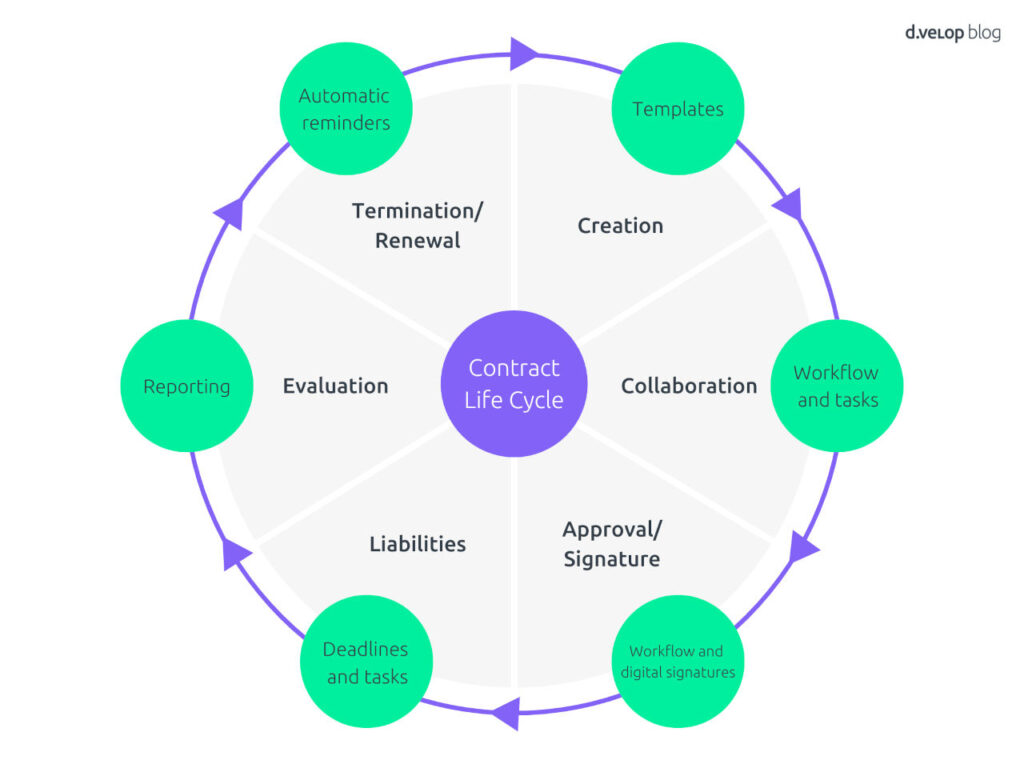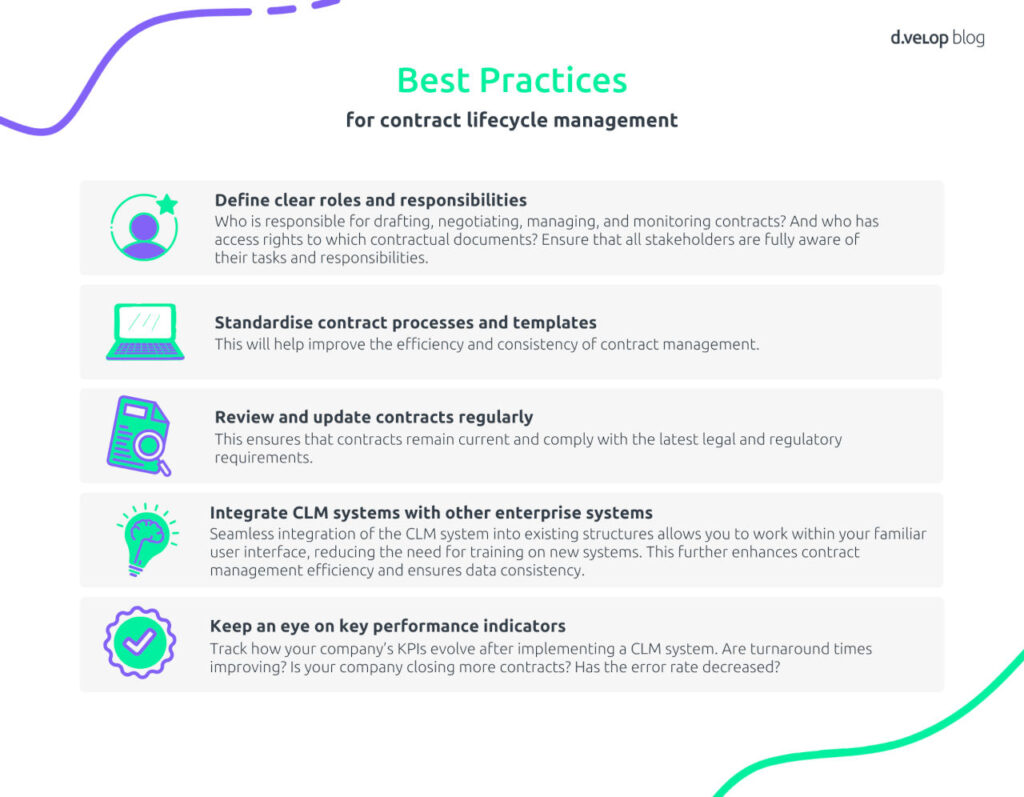Contracts are an essential part of the business world. They govern the relationships between companies and their customers, suppliers, partners and other business partners, for example when purchasing vehicles or renting property. Contracts can be extremely complex and extensive, and their management time-consuming and error-prone. In a dynamic business world, well thought-out contract lifecycle management (CLM) can make all the difference in making contract management more efficient and effective. Find out how you too can benefit from a CLM system in this blog article.
Definition: What is contract lifecycle management?
Contract lifecycle management (CLM) is an approach to the systematic management of the entire lifecycle of contracts. This includes the creation, negotiation, execution, monitoring, termination and archiving of contracts in equal measure. A contract management tool helps companies to manage contracts more efficiently, transparently and securely by providing automated workflows, centralised filing and deadline monitoring. The aim is to minimise risks, reduce costs and promote collaborative working.
The 6 phases of the contract life cycle

The contract life cycle comprises the following phases:
1st phase: Creation
In this phase, standardised contract templates are created that serve as the basis for new contracts and enable efficient contract creation.
2nd phase: Review
Here, the contracts created are run through a defined workflow that includes various tasks and checks to ensure that the contracts meet the required standards and guidelines.
3rd phase: Approval
Once reviewed, the contracts are forwarded to the relevant individuals or departments for approval and authorisation before they become legally binding.
Phase 4: Commitments
In this phase, the liabilities specified in the contract, such as deadlines and tasks, are monitored and managed to ensure that they are fulfilled on time and that there are no breaches of contract.
5th phase: Compliance
This is where contract compliance is monitored and reporting and evaluations are carried out to ensure that all relevant rules and regulations are adhered to.
6th phase: Cancellation/contract renewal
In this phase, automatic reminders and processes are set up to remind you of upcoming cancellation or renewal dates and to ensure a smooth process for contract terminations or renewals.
Why is contract lifecycle management important?
Contract lifecycle management is important for companies because it helps them to keep a better eye on their contracts. Contract lifecycle management software helps companies to manage contracts efficiently in all the phases mentioned. This brings a number of benefits:
Increased efficiency and time savings: CLM systems help to increase the efficiency of contract management by automating tasks such as the creation, negotiation, management, monitoring and archiving of contracts. This leads to time and cost savings.
Risk minimisation and legal compliance: CLM software helps companies to minimise risks. It promotes compliance with legal and regulatory requirements and automates the monitoring of contractual obligations. This includes deadline management, for example. This can avoid costly legal disputes.
Improved transparency: CLM software helps companies manage their contracts more transparently by centralising all contract information in one place and making it easier to access.
Greater collaboration and communication: CLM systems can promote collaboration and communication between different departments and stakeholders by providing a common data repository and platform for communication, so that contracts can be shared across departments.
Digital signature: With electronic signature software as part of CLM software, contracts can be signed quickly and easily from anywhere and collaboration in contract management can be improved. The reason: All contract information is centralised in one place, usually a document management system. Digital contract signing can also reduce the risk of errors in contract management because the digital signature prevents manual input errors.
Advantages of Contract Lifecycle Management
CLM systems offer a number of benefits for organisations, including:
- Increased efficiency and time savings: CLM systems help to increase the efficiency of contract administration by automating tasks such as the creation, negotiation, management, monitoring and archiving of contracts.
- Risk minimisation and legal compliance: CLM systems help companies to minimise their risks by supporting companies in meeting legal compliance requirements. This can avoid costly legal disputes.
- Cost reduction and improved cost management: CLM systems help companies to optimise their contract processes.
- Improved transparency and reporting: CLM systems improve transparency and reporting by centralising all contract information in one place and simplifying access to it. This creates a better overview of contract portfolios.
- Digital signature: With electronic signature software as part of CLM software, contracts can be signed quickly and easily from anywhere and collaboration in contract management can be improved. The reason: All contract information is centralised in one place, usually a document management system (EDMS). Digital contract signing can also reduce the risk of errors in contract management because the digital signature prevents manual input errors.
- Greater collaboration and communication: CLM systems can promote collaboration and communication between different departments and stakeholders by providing a common data repository and platform for communication.
What functions should a good CLM offer you?
Finding the right contract management software can be difficult. Good contract management software includes deadline management, offers structured and centralised overviews of company contracts and should enable location-independent collaborative work. In addition, the software should support digital signing using a qualified electronic signature so that the entire contract lifecycle can be organised digitally. Depending on the requirements, a good CLM should therefore offer the following functions to significantly increase efficiency in your company:
- Centralised storage and management of contracts
- Automated monitoring of contract deadlines
- Ensuring compliance with contractual obligations
- Automation of workflows for contract execution
- Proactive contract monitoring to avoid contract renewals
- Smooth processing of contract terminations
- Contract archiving
- Digital signature
Selecting and implementing a CLM system
To find the right software for your contract lifecycle management, you need to clarify a few basic ideas. Probably the most important: You shouldn’t choose a stand-alone solution so that you can continue to use your existing infrastructure, such as Microsoft 365. The contract lifecycle management system should be compatible with all your other systems so that you can import and export data from other systems into the CLM system. Further steps are:
- Determine the requirements: What do you want to achieve with your CLM system? What are the most important problems you want to solve?
- Research: There are many different contract lifecycle management systems on the market. Compare the different systems and choose the one that best suits your requirements.
- Test the system: Before you implement contract management software, it is important to test it. Make sure that the system meets your requirements and that you can use it easily.
- Implement: Once you have selected a contract management system, you need to implement it. This includes making the system available to your employees and training them.
- Use the system: Once the contract management tool is implemented, you can use it to manage your contracts. Use the system to create, manage and archive your contracts.
A good tip: Get support from an experienced digitiser if you are not sure how to select and implement a CLM system. A consultant will help you determine your requirements, select the right system and implement it successfully.
Best practices for contract lifecycle management
Organisations looking to manage their contracts more efficiently, effectively and securely can take inspiration from these best practices.
- Define clear roles and responsibilities. Who is responsible for creating, negotiating, managing and monitoring contracts? And who has access rights to which contract documents? Make sure that everyone involved is clear about their tasks and responsibilities.
- Standardise contract processes and templates. This will help to improve the efficiency and consistency of contract management.
- Review and update contracts regularly. This will ensure that contracts are still up to date and comply with current legal and regulatory requirements.
- Integrate CLM systems with other company systems. This will help you to further improve the efficiency of contract management and ensure data consistency.

Technologies and trends in contract lifecycle management
CLM is also developing rapidly due to technological innovations and new requirements. New technological possibilities should be utilised in order to create the most efficient way of working.
- Artificial Intelligence and automation: AI-supported systems automate routine tasks such as contract creation, review and approval. Machine learning can also help to analyse risks and predict contractual problems.
- Cloud-based solutions: Contract management software in the cloud maps the entire contract lifecycle regardless of location. This leads to greater security, scalability and efficiency. Especially with increasing numbers of people working from home, it is advantageous to have remote access to all important contracts.
- E-signatures: Signing contracts online can save an enormous amount of time and money. It allows you to work more efficiently and supports the approach of a modern digital workplace.
Contract management with d.velop
d.velop’s contract management software enables companies to store and manage all their contracts in one central location. It can automatically monitor deadlines and contract terms in the digital deadline calendar and send notifications when a contract expires or cancellation deadlines are approaching. Contracts can be searched for and found in seconds. With d.velop sign, contracts can be signed online without many additional steps. Seamless integration into various systems is also possible. For example, integration into Microsoft Outlook means that correspondence and additions to contracts can be filed directly from Outlook and assigned to the corresponding files. This also promotes collaborative working. Schalke04 also relies on d.velop for its contract management. Find out more about the d.velop solution in use at Schalke 04.
More efficiency, less risk, improved transparency
A well-designed Contract Lifecycle Management (CLM) system transforms the way businesses handle their contracts. Each stage of contract creation, implementation, and review requires careful management to minimise risks and maximise opportunities. With the right CLM software, contracts can be stored centrally, deadlines monitored, and contractual obligations fulfilled automatically. Ultimately, effective CLM not only enhances internal processes but also strengthens relationships with partners and clients through clearly defined agreements and open communication.
Contract management at its best
7 facts about contract management with Microsoft 365
